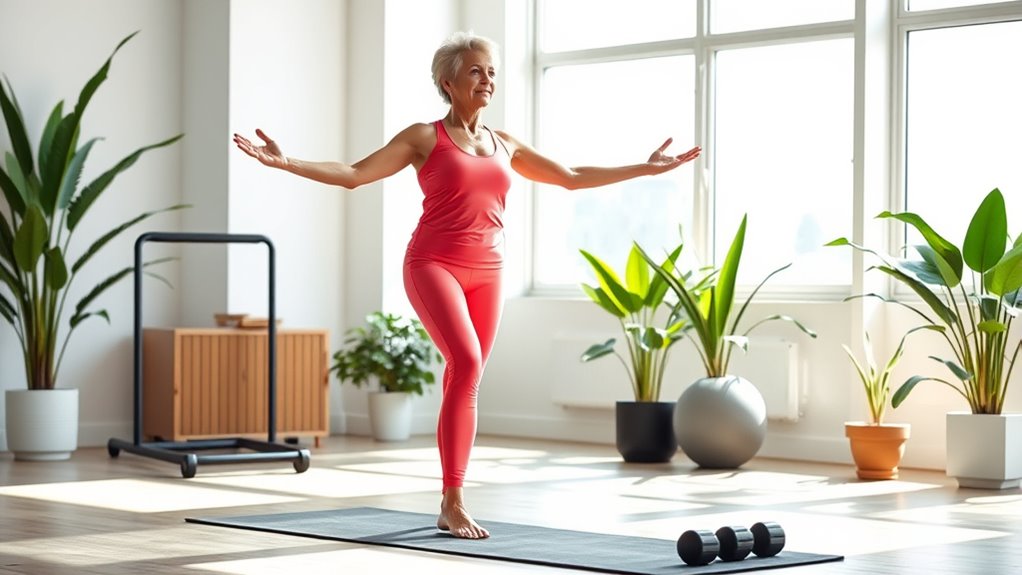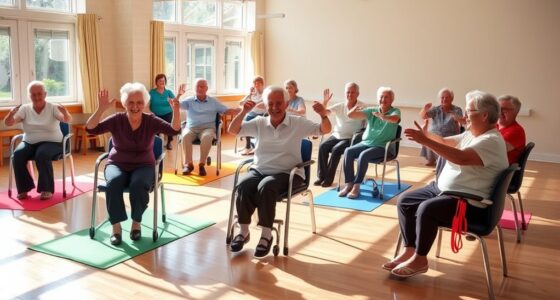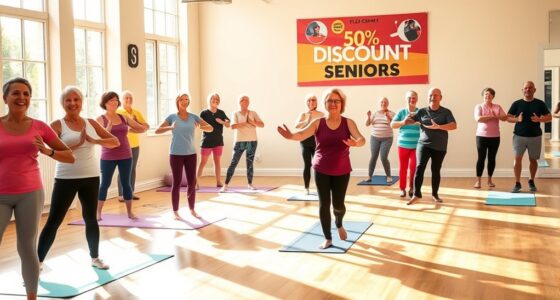To prevent falls, focus on strengthening your core, practicing standing balance exercises, and improving body awareness. Try standing leg lifts, heel-to-toe walks, tandem stance, and chair sit-to-stands regularly. Incorporate gentle yoga or tai chi to boost coordination and confidence. Always make certain a safe environment, use supports if needed, and pay attention to mindful movement. Keep practicing these techniques, and you’ll discover more effective ways to stay steady and secure.
Key Takeaways
- Incorporate core strength exercises to improve stability and control during single-leg and support-based activities.
- Practice standing balance drills like heel-to-toe walks and tandem stances to enhance ankle stability and proprioception.
- Use mindful movement and sensory cues to deepen body awareness and reinforce neural pathways for better balance.
- Ensure a safe environment with supportive aids, clear pathways, and proper footwear to reduce fall risk during exercises.
- Include dynamic and mind-body practices such as Tai Chi and yoga to improve coordination, posture, and overall balance.
Standing Leg Lifts

Standing leg lifts are a simple yet effective exercise to improve your balance and strengthen your lower body. To begin, stand tall with your feet hip-width apart, focusing your visual focus on a fixed point ahead. As you lift one leg to the side, keep your ankle stable and engage your core to maintain stability. This movement enhances ankle strengthening, which is vital for maintaining balance and preventing falls. Keep your movements controlled and avoid leaning or shifting your torso. Switch legs and repeat, aiming for smooth, deliberate lifts. By concentrating on your visual focus, you help your brain coordinate better with your muscles. Incorporating this exercise into your routine can boost your overall stability and reduce the risk of falls. Proper technique and consistent practice are key to maximizing benefits and minimizing injury risk. Additionally, practicing a variety of eye patch benefits can improve hand-eye coordination and dexterity, further contributing to better balance and functional movement.
Heel-to-Toe Walks

When you practice heel-to-toe walks, focus on maintaining proper walking technique to improve your balance. This exercise also helps increase your body awareness as you coordinate your movements carefully. Remember to follow safety tips and make adjustments if you feel unstable to prevent falls. Being mindful of balance improvement strategies can enhance your overall stability and reduce the risk of falls over time.
Proper Walking Technique
Mastering proper walking technique, such as heel-to-toe walking, can substantially improve your balance and stability. Your footwear choices play a vital role—wear shoes with good support and non-slip soles to reduce the risk of slips. When walking, focus on placing your heel down first, then rolling through to your toes, maintaining a steady rhythm. Be mindful of environmental hazards like uneven surfaces, loose rugs, or clutter that can cause trips or falls. Clear pathways and choose well-lit areas to lessen these risks. Practicing this controlled, deliberate gait helps strengthen your muscles and enhances coordination. Paying attention to your footwear, surroundings, and incorporating balance-enhancing activities can create a safer environment that supports your efforts to improve balance and prevent falls. Additionally, engaging in activities that stimulate brainwave patterns associated with balance can further reinforce your stability and confidence while walking. Incorporating muscle strengthening exercises can also improve overall stability and reduce fall risk over time. Furthermore, understanding the role of visual cues in maintaining equilibrium can help you adapt to different environments and improve your overall safety while walking.
Enhancing Body Awareness
Building on your walking technique, focusing on heel-to-toe walks helps enhance your body awareness and coordination. As you perform this exercise, pay attention to your movements, integrating mindful breathing to stay present. Breathe steadily and intentionally, which helps you connect with your body’s sensations and improve sensory integration. Feel the contact between your heel and the ground, then shift your weight smoothly to your toes. This mindful approach heightens your awareness of balance cues, allowing you to detect subtle shifts in your stability. Concentrating on each step sharpens your proprioception and reinforces neural pathways associated with coordination. Over time, this practice trains your body to respond more effectively to balance challenges, reducing fall risk through improved body awareness and sensory integration. Incorporating mindful movement can further deepen your body awareness and support balance training. Lesser-known spots provide tranquil environments that can further support mindful movement practices. Exploring sensory integration techniques can also enhance your body’s ability to process balance cues more efficiently.
Safety Tips and Adjustments
To guarantee safety while performing heel-to-toe walks, it’s important to start with a stable environment and use supports if needed. Clear the area of environmental hazards like loose rugs or clutter that could cause falls. Be aware that medication effects, such as dizziness or slowed reaction times, can increase your fall risk, so consider performing this exercise when you’re less affected. Use a sturdy chair or wall nearby for balance support until you feel confident. Avoid practicing on uneven surfaces or slippery floors. Always listen to your body—stop if you experience dizziness or discomfort. Adjust your pace as necessary, and never rush. These precautions help prevent falls and ensure you gain the benefits safely.
Single-Leg Stands

Doing single-leg stands helps you improve your balance control, making daily movements easier and safer. As you hold the pose, your core muscles engage automatically, boosting your overall strength. This simple exercise is a powerful way to enhance stability and core stability simultaneously. Incorporating balance exercises into your routine can further support fall prevention and overall mobility. Using portable camping gear, such as lightweight tents and portable power sources, can also help maintain your energy and safety during outdoor activities. Engaging in personal growth practices like mindfulness can further improve your focus and stability, especially when combined with specialized indoor gardening tools like unique planters that promote a calming environment.
Improving Balance Control
Improving your balance control begins with mastering single-leg stands, a simple yet effective exercise. By focusing on ankle stability and using visual cues, you enhance proprioception and coordination. To envision this, imagine standing on one foot, steady and confident, as your eyes track a fixed point. This visual cue helps maintain focus and improves balance. As you practice, visualize the following:
| Stable Surface | Unstable Surface |
|---|---|
| Firm ground | Foam pad or wobble board |
| Solid support | Moving or uneven terrain |
| No distractions | Distracting environment |
This imagery emphasizes the importance of controlling ankle stability and relying on visual cues to stay balanced. Consistent practice strengthens your ability to maintain equilibrium in daily activities. Additionally, understanding the Responsibilities of Balance can motivate you to stay committed to these exercises. Recognizing how Celebrity Transformations often involve physical discipline can inspire your dedication to balance exercises. Developing Kia Tuning techniques such as suspension upgrades can be metaphorically linked to enhancing your body’s stability and responsiveness during balance training. Incorporating Glycolic Acid Benefits into skincare routines can also support your overall wellness by promoting skin health, which complements your active lifestyle.
Enhancing Core Strength
Building a strong core is key to maintaining balance during single-leg stands. A stable core helps you stay upright and prevents falls. Focus on posture correction by engaging your abdominal muscles and keeping your spine aligned. Incorporate breathing exercises to improve stability; deep, controlled breaths activate your core muscles and promote better control. As you lift one leg, tighten your core muscles and maintain a neutral spine. Practice slow, steady breathing to enhance concentration and muscle engagement. Strengthening your core not only improves balance but also reduces strain on your lower back and enhances overall posture. Additionally, understanding the importance of data privacy challenges can motivate you to stay consistent and mindful during your exercises. Maintaining awareness of mindful movement techniques can further enhance your stability and prevent injuries. Regularly performing single-leg stands with attention to breathing and posture correction builds resilience, making you more confident and secure on uneven surfaces or when multitasking. Including core stability exercises in your routine can accelerate progress and long-term balance benefits.
Tandem Stance Exercises

Tandem stance exercises challenge your balance by requiring you to stand with one foot directly in front of the other, creating a narrow base of support. This position forces you to engage your ankle flexibility and stabilize your core. To improve your balance further, focus on maintaining steady vision exercises—keep your gaze fixed on a point ahead without shifting your head. As you hold the stance, you’ll develop better proprioception and strengthen muscles that support ankle stability. If you feel unsteady, start near a wall or chair for support, then gradually reduce assistance. Regular practice enhances your ability to maintain balance in daily activities, reducing fall risk. Remember, consistency is key to seeing improvements in stability and confidence.
Chair Sit-to-Stand Movements

Chair sit-to-stand movements are a simple yet effective exercise to enhance your lower body strength and balance. To start, choose a sturdy chair with a height that allows your knees to bend at about 90 degrees when seated. Sit upright with your feet flat on the floor, roughly hip-width apart. Place your hands lightly on your thighs or across your chest, depending on your comfort level. Engage your core, then press through your heels to stand up smoothly, keeping your back straight. Slowly lower yourself back into the chair with control. Focus on maintaining proper hand placement to support stability, especially if you’re just beginning. Performing this exercise regularly helps improve your leg strength and balance, reducing fall risk over time.
Toe and Heel Raises

Toe and heel raises are simple yet effective exercises that target your lower leg muscles, helping to improve balance and stability. These movements enhance ankle flexibility and toe coordination, which are essential for preventing falls. To perform them:
- Stand with feet hip-width apart, hold onto a chair for support if needed.
- Rise onto your toes, lifting your heels as high as possible, then lower slowly.
- Next, lift your toes off the ground while keeping your heels down.
- Repeat these movements for 10–15 repetitions, focusing on controlled motion.
Incorporating toe and heel raises regularly can strengthen the muscles around your ankles, boost your balance, and enhance coordination, making everyday activities safer.
Gentle Yoga Poses for Balance

Gentle yoga poses can effectively enhance your balance by focusing on controlled movements and mindful posture. As you practice, incorporate breathing techniques to maintain calmness and improve concentration. Deep, steady breaths help center your attention, making it easier to hold poses steadily. Meditation practices, like mindful awareness of your body, deepen your connection to balance and stability. Poses such as Tree Pose or Warrior III, done slowly and intentionally, strengthen the core and legs while promoting better proprioception. These gentle movements encourage you to listen to your body, refine your posture, and develop stability over time. Regular practice not only boosts physical balance but also reduces anxiety and increases mindfulness, contributing to a more confident and steady stance in daily life.
Tai Chi Movements

Have you ever wondered how Tai Chi movements can improve your balance? These gentle, flowing motions help strengthen your muscles, enhance coordination, and promote mindfulness meditation, which reduces stress and sharpens focus. To get started, try:
Tai Chi improves balance by strengthening muscles, enhancing coordination, and promoting mindfulness to reduce stress and increase focus.
- Practicing slow, deliberate shifts to develop body awareness.
- Incorporating vision exercises to improve spatial perception.
- Focusing on breath control to increase stability.
- Synchronizing movements with mindful meditation to boost concentration.
Tai Chi encourages you to stay present, making you more aware of your body’s position and movements. This heightened awareness can reduce falls by improving your reaction time and stability. Regular practice not only builds strength but also trains your mind to stay centered, fostering overall balance.
Dynamic Balance Drills

Building on the balance benefits gained from Tai Chi, incorporating dynamic balance drills can further challenge your stability in real-world situations. These exercises improve ankle flexibility, which is essential for maintaining control during movement. Try walking heel-to-toe along a straight line or shifting your weight side to side while standing on one leg. As you perform these drills, focus your visual attention steadily on a fixed point ahead; this enhances your visual focus, helping you stay balanced when your surroundings shift unexpectedly. Dynamic balance drills simulate everyday movements, strengthening your ability to react quickly and stay upright. Consistently practicing these exercises will boost your confidence and reduce fall risk by improving your overall stability and responsiveness.
Frequently Asked Questions
How Often Should I Perform These Balance Exercises Weekly?
You’re wondering about exercise frequency and the ideal schedule for your balance exercises. To see benefits, aim for at least two to three sessions per week. Consistency is key, so plan your workouts on non-consecutive days to allow recovery and maintain progress. Adjust the schedule as needed based on your comfort and improvement. Regular practice helps strengthen muscles and enhances stability, reducing fall risks effectively.
Are These Exercises Suitable for All Age Groups?
Thinking balance exercises are one-size-fits-all? Think again. Age-specific adaptations matter, and exercise safety considerations are vital. You’ll want different routines if you’re a toddler or a retiree. While these exercises can benefit all ages, tailoring them ensures safety and effectiveness. Always consult a healthcare professional to adapt exercises to your age and condition—because falling isn’t just for toddlers, and safe movement is for everyone.
Can These Exercises Improve Balance After a Fall?
After a fall, these exercises can help improve your balance by focusing on fall recovery and muscle strengthening. They target key muscles used for stability, making you less likely to fall again. Consistent practice boosts your confidence and coordination, aiding your recovery process. While they won’t instantly fix all issues, they are a valuable part of regaining strength and balance after a fall. Always consult your healthcare provider before starting new exercises.
What Precautions Should I Take Before Starting These Exercises?
Think of preparing your body as tending a garden before planting. Before starting balance exercises, you should follow gentle warm-up routines, just like watering your plants to awaken them. Make sure you wear proper footwear for stability, like sturdy soil supporting growth. Check your space for hazards, and if you have health issues, consult your doctor. These steps protect your foundation, helping you build strength safely and confidently.
Do These Exercises Help Prevent Specific Health Conditions?
These exercises can help prevent specific health conditions like falls, osteoporosis, and muscle weakness. However, you should be conscious of potential medication interactions that might affect your ability to perform them safely. Also, there’s a risk of injury if you push yourself too hard or do exercises improperly. Always consult your healthcare provider before starting new routines to ensure they’re appropriate for your health status and to minimize injury risks.
Conclusion
By incorporating these balance-boosting exercises into your routine, you strengthen your stability, improve your coordination, and enhance your confidence. You’ll stand taller, move safer, and fall less often. You’ll build resilience, develop awareness, and foster independence. With consistency, these exercises become your shield against falls, your foundation for safety, and your path to a healthier, more balanced life. Commit today, and watch your confidence and stability grow stronger every day.









